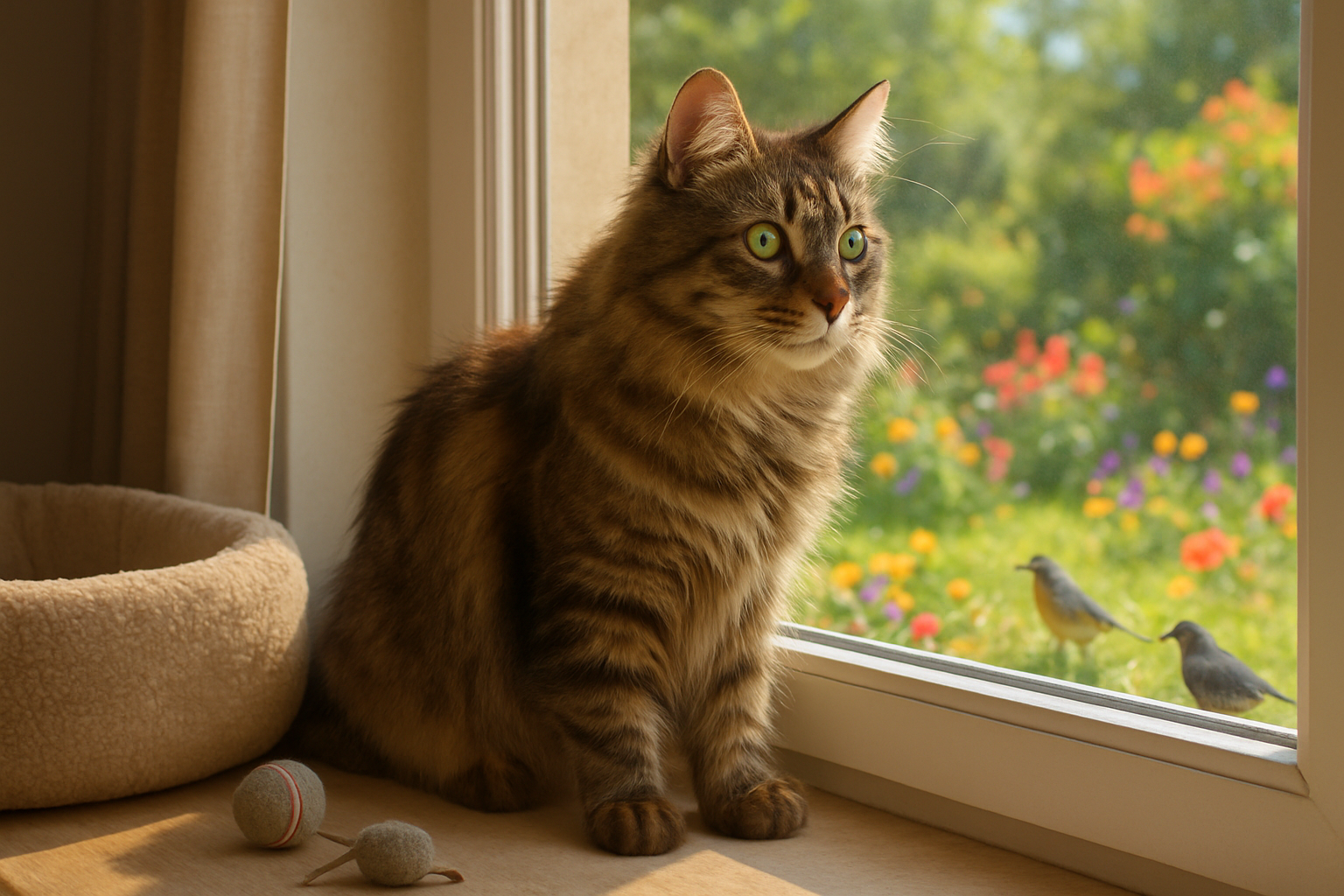When you’re cozying up with your furry friend, it’s natural to wonder if they’d enjoy having a companion. Cats are famously independent, but many still crave social bonds, especially in households where their humans are away for long hours. Deciding whether your cat would benefit from a new buddy isn’t always clear-cut. Sometimes, subtle hints in their behavior might reveal a longing for friendship, while other times, it’s just their quirky nature shining through. Understanding these signals can drastically improve your cat’s quality of life and help you avoid introducing stress into their space. From the classic “clingy cat” to the occasionally aloof feline, their personality plays a massive role in how they’d react to a new companion. Let’s unpack the behavioral clues, common concerns, and expert tips for adding that second cat and how the right introduction can turn two lone wolves into best pals.
Recognizing the Signs That Your Cat May Want a Feline Friend 🐾
Cats primarily communicate through body language and subtle sounds, so deciphering their desire for a friend can feel like decoding a secret message. When wondering, “how do I know if my cat wants a friend?”, look for distinct behavioral patterns that suggest loneliness or a craving for companionship.
- 🥺 Increased Clinginess: If your cat follows you everywhere, seeking constant attention or physical closeness, it might mean they’re feeling lonely and want a pal to share their world.
- 🗣️ Excessive Vocalization: Continuous meowing or yowling, especially when you’re not around, often signals that your cat feels isolated.
- 😿 Withdrawal or Depression: A notable drop in activity levels, less play, and hiding away frequently can indicate a lack of social stimulation.
- 🧹 Scruffy Grooming: Cats who neglect their grooming may be stressed or unhappy, sometimes due to loneliness.
- 🎾 Playmate Seeking Behavior: Your kitty might bat at toys or make playful gestures at empty spots, hinting they wish for another cat to romp around with.
These signs are worth noting, but be mindful — some cats just have quirky personalities. For example, Maine Coons are famously sociable cats. If your feline shows signs of discomfort or stress, a new feline companion could be beneficial. Conversely, some cats prefer to rule the roost solo, in which case, adding another might complicate things.
Veterinarians and behaviorists often stress that not all cats respond similarly. For example, “Cats are social animals that benefit from some feline interaction,” explains a leading vet. But others highlight that hasty introductions can cause severe stress due to their territorial instincts. So, it’s crucial to monitor your cat’s behavior and consider their individual preferences before making a move.
| Sign 🐱 | Meaning 🔍 | What To Do Next 🛠️ |
|---|---|---|
| Clingy Behavior | Cat may feel lonely | Spend quality time or consider a playmate |
| Excessive Meowing | Boredom or seeking attention | Provide toys or introduce another cat cautiously |
| Scruffy Appearance | Stress or depression | Vet visit + environment enrichment |
| Withdrawn & Hiding | Possible loneliness or illness | Observe closely + vet consult |
| Playful Gestures at Empty Spaces | Desire for social play | Introduce toys and consider a companion |
Learn more about understanding your cat’s social needs if you suspect your feline may be craving a friend but want to avoid unexpected escapes or stress.
How to Carefully Introduce a New Cat to Your Household Without Stress 🐈⬛🤝🐈
The phrase “introducing cats” might bring to mind epic standoffs or fr enemy-like silent treatments. However, there’s a proven method to help your existing cat and newcomer bond gradually, minimizing tension and competition. Before rushing out to PetSmart or Chewy for that adorable kitten, consider these essential steps:
- 🏠 Separate Spaces: Keep the new cat in a separate room initially with their own food, litter, and toys.
- 👃 Scent Swapping: Exchange bedding between cats so they can familiarize themselves with each other’s scent without direct contact.
- 👀 Visual Introductions: Allow cats to see each other through a gate or a cracked door for supervised sessions.
- 🎯 Short Controlled Meetings: Arrange brief interactions while monitoring body language closely, looking for relaxed postures.
- 🤲 Positive Reinforcement: Reward calm behavior with treats (brands like Friskies or Purina treats work wonders!) to encourage friendly associations.
- ⌛ Patience is Key: The whole process can take weeks or months, so don’t rush it!
This careful and respectful approach helps avoid confrontation arising from a cat’s natural territorial tendencies. Remember that cats can get territorial over their favorite resting spots, food bowls (stocking extra from Petco or Chewy is smart), and litter boxes, so ensuring multiple resources is vital.
| Step 🦶 | Why? 🤔 | Pro Tip 🐕🦺 |
|---|---|---|
| Separate Spaces | Prevents immediate confrontations | Use Catit automatic feeders to keep meal times smooth |
| Scent Swapping | Helps cats recognize each other gently | Swap toys and blankets too |
| Visual Introductions | Familiarizes cats without physical stress | Use window perches or play with them at the gate |
| Short Meetings | Builds trust gradually | Keep sessions under 10 minutes initially |
| Positive Reinforcement | Encourages peaceful behavior | Use favorite treats like Meow Mix or Whiskas |
Patience is more than a virtue here; it’s the secret to a long-lasting friendship between your cats. Prioritize their comfort and observe all signs closely. If any aggressive behavior escalates, separate the cats and try slower introductions.
Understanding Cat Personalities: Who’s More Likely to Enjoy a Feline Companion? 😻
Not all cats are social butterflies — some prefer solitary existence, while others thrive in feline company. Recognizing your cat’s personality can be the difference between a love story and a full-blown soap opera in your living room.
Types of Cat Personalities and Their Compatibility
- 🛋️ Solo Sovereign: These cats cherish their alone time, territorial and sometimes suspicious of newcomers.
- 🤗 The Social Butterfly: Outgoing and eager to make friends, they often initiate play and snuggle sessions.
- 🐆 The Hunter-Playmate: Active cats who love interactive play and may appreciate a buddy to chase toys with.
- 🧘 Independent-but-Sociable: Cats who enjoy autonomy but also value occasional feline company.
It’s essential to align your new cat’s temperament with your existing pet’s preferences. For instance, a shy, reserved cat might struggle when suddenly introduced to a boisterous kitten. Some breeds, like Maine Coons (see this detailed guide), are known for their laid-back and social nature, which can make them excellent companions for an existing cat.
On the other hand, a naturally territorial or anxious cat might prefer having human attention exclusively. Brands like Purina and Meow Mix often suggest enriching toys and solo playtime for such personalities to keep their contentment high.
| Personality Type 🎭 | Traits 🐾 | Best Companion Match 💞 |
|---|---|---|
| Solo Sovereign | Territorial, reserved | Quiet, calm cat or no companion |
| Social Butterfly | Affectionate, playful | Kittens or friendly adult cats |
| Hunter-Playmate | Active, playful | Playful companions of similar energy |
| Independent-but-Sociable | Balanced social needs | Companion who respects space |
By tuning into your cat’s mood and habits, you can better predict whether a new cat will improve or disrupt their world.
Essential Tips to Create a Harmonious Multi-Cat Home 🏠🐾✨
Bringing a new feline into your home means adjusting infrastructure to accommodate multiple personalities and prevent turf wars. Here’s how to set the stage for a happy, stress-free multi-cat household.
- 🍽️ More Bowls, Please: Each cat should have their own feeding spot with separate food and water bowls to prevent dominance fights. Brands like Friskies and Whiskas offer yummy options that most cats love.
- 🚽 Litter Box Strategy: The rule of thumb is one litter box per cat, plus one extra. Using high-quality products like Feline Pine or Tidy Cats can keep the area fresh and inviting.
- 🛏️ Multiple Resting Areas: Different cozy spots, from window perches to Catit tunnels, provide space for each cat to have their own territory.
- 🎾 Interactive Play: Invest in stimulating toys and rotate them regularly to keep all cats mentally and physically engaged.
- ⚠️ Conflict Watch: Be aware of body language signaling stress or aggression and intervene early.
These steps not only reduce territorial disputes but foster positive interactions and meaningful feline friendships. Multiple resources mean everyone gets their share without feeling threatened, which is crucial for peaceful coexistence.
| Essential Resource 🌟 | Recommended Quantity ➕ | Suggested Brands 🏆 |
|---|---|---|
| Food & Water Bowls | One per cat | Purina, Meow Mix |
| Litter Boxes | Number of cats + 1 | Tidy Cats, Feline Pine |
| Resting Areas | At least two spots per cat | Catit, DIY window perches |
| Toys & Play Items | Varied and rotated regularly | Petco, Chewy selections |
Common Concerns About Adding a Second Cat – Expert Answers Revealed 🐱❓
Deciding whether your feline might appreciate a companion can come with lots of questions. Let’s tackle the top concerns that cat owners frequently ask:
- 😾 Will my cat be territorial toward a new cat? Yes, cats naturally claim territory. Controlled introductions reduce conflict potential.
- 🤔 How do I know if my cat really wants a friend? Look for behavior changes like clinginess, vocalizing, or withdrawal.
- ⃠ What if my cats don’t get along? Be ready to separate and try other introduction methods; not all cats bond.
- 🙀 Will my cat feel neglected? Ensure both cats receive attention and resources to avoid jealousy.
- ⌛ How long to wait for cats to bond? It varies—patience and proper introduction are key.
Sometimes, cats need human interaction more than a feline friend. Investing in quality time and stimulating toys might help, but adding a buddy could be the best solution for some. Familiarizing yourself with these answers enlightens your approach to a happier, healthier home.
Frequently Asked Questions ❓
- Q: How can I tell if my cat is lonely?
A: Look for signs like increased meowing, clinginess, lack of play, or scruffy grooming habits. - Q: Can I introduce a kitten to an adult cat?
A: Yes, kittens are often more accepted because of their playful nature, but introductions still require patience and gradual steps. - Q: What resources should I have for two cats?
A: Each cat should have separate food bowls, litter boxes (number of cats + 1), and multiple resting spots to avoid territorial disputes. - Q: How do I handle aggression between cats?
A: Separate them immediately and consult a vet or animal behaviorist; slow down introductions with positive reinforcement. - Q: Will adding a cat make my current cat happier?
A: Many cats thrive with companions, but some prefer solitude; always consider your cat’s personality and behavior before deciding.

